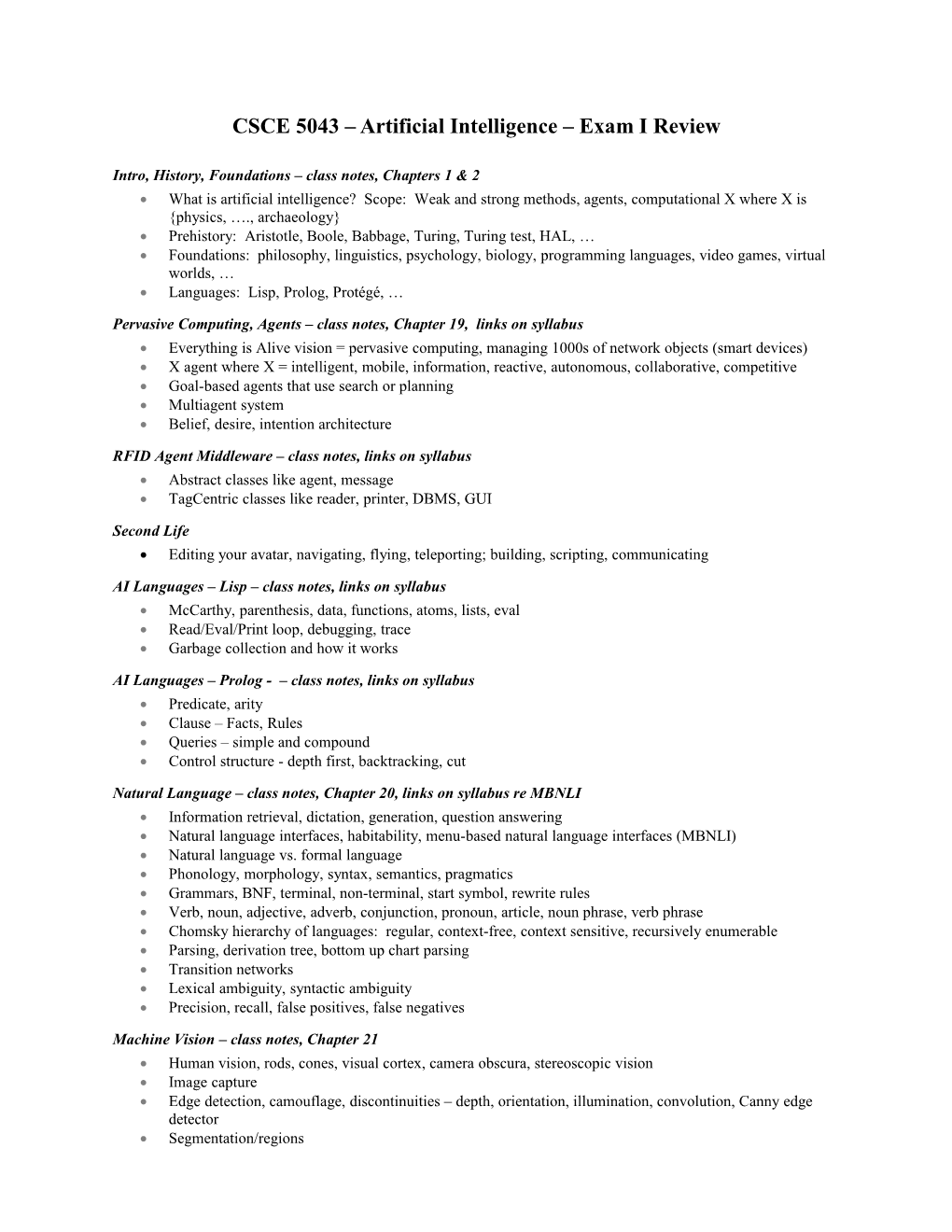Artificial Intelligence CSCE 4613/5043

CSCE 5043 – Artificial Intelligence –Exam I Review
Intro, History, Foundations – class notes, Chapters 1 & 2
- What is artificial intelligence? Scope: Weak and strong methods, agents, computational X where X is {physics, …., archaeology}
- Prehistory: Aristotle, Boole, Babbage, Turing, Turing test, HAL, …
- Foundations: philosophy, linguistics, psychology, biology, programming languages, video games, virtual worlds, …
- Languages: Lisp, Prolog, Protégé, …
Pervasive Computing, Agents – class notes, Chapter 19, links on syllabus
- Everything is Alive vision = pervasive computing, managing 1000s of network objects (smart devices)
- X agent where X = intelligent, mobile, information, reactive, autonomous, collaborative, competitive
- Goal-based agents that use search or planning
- Multiagent system
- Belief, desire, intention architecture
RFID Agent Middleware – class notes, links on syllabus
- Abstract classes like agent, message
- TagCentric classes like reader, printer, DBMS, GUI
Second Life
- Editing your avatar, navigating, flying, teleporting;building, scripting, communicating
AI Languages – Lisp – class notes, links on syllabus
- McCarthy, parenthesis, data, functions, atoms, lists, eval
- Read/Eval/Print loop, debugging, trace
- Garbage collection and how it works
AI Languages – Prolog - – class notes, links on syllabus
- Predicate, arity
- Clause – Facts, Rules
- Queries – simple and compound
- Control structure - depth first, backtracking, cut
Natural Language – class notes, Chapter 20, links on syllabus re MBNLI
- Information retrieval, dictation, generation, question answering
- Natural language interfaces, habitability, menu-based natural language interfaces (MBNLI)
- Natural language vs. formal language
- Phonology, morphology, syntax, semantics, pragmatics
- Grammars, BNF, terminal, non-terminal, start symbol, rewrite rules
- Verb, noun, adjective, adverb, conjunction, pronoun, article, noun phrase, verb phrase
- Chomsky hierarchy of languages: regular, context-free, context sensitive, recursively enumerable
- Parsing, derivation tree, bottom up chart parsing
- Transition networks
- Lexical ambiguity, syntactic ambiguity
- Precision, recall, false positives, false negatives
Machine Vision – class notes, Chapter 21
- Human vision, rods, cones, visual cortex, camera obscura, stereoscopic vision
- Image capture
- Edge detection, camouflage, discontinuities – depth, orientation, illumination, convolution, Canny edge detector
- Segmentation/regions
- Classifying edges in line drawings – convex (+), concave (-), occluding (). Trihedral vertices – 16, Waltz labeling, ambiguous labeling
- Texture – identifying textures via co-occurrence matrices, texels – shape and orientation
- Motion – motion field of vectors
- Model – invariant properties, arches, near miss examples
Search – class notes, Chapter 4, 5
- Control strategies, game trees, brute force, blind search, informed search, heuristic evaluation function
- Properties: complexity in time or memory, completeness, optimality, irrevocability
- Depth first search, breadth first search, bi-directional search, hill climbing, beam search, A*, uniform cost, greedy, simulated annealing, genetic algorithms
Game Theory – class notes, Chapter 6
- Game trees, evaluation function
- Assumptions: rationality, zero sum
- Minimax, Alpha-Beta
- Tic-tac-toe, checkers, chess, go
